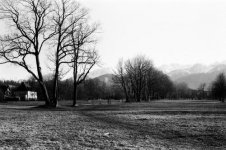Apart from missing the right tonality in your example, the grain is indeed there but i am missing overall sharpness in the example.
When using any ultra fine grain type developer you will have speed loss of about 1 F stop which means you have to expose the FP200 on E.I. 100. That said with a dilution of 1+0. when using 1+1 or 1+2 you are diluting more hence the overall concentrate of Sodiumsulfite and Sodiumchloride/Potassiumchloride is getting less so apart you have more sharpness your speed loss is less then 1 F stop, around 1/2 F stop then. In this way you can control: 1. sharpness, 2. grain, 3. film speed.
To keep film speed and fine grain in the past there were two options: Promicrol (May & Baker) and Atomal (Agfa Gevaert). However the HEAP in both of these developers were strong carcinogenic and the production of the HEAP was stopped somewhere in the 70's. Later Kodak made Xtol in 1995 containing Ascorbic Acid (Vit. C) which had the same effect. However the keeping quality of most Ascorbic Acid type developers are poor: Xtol, Ilfosol-S, Ilfosol-3 (a bit better), FX-50, Fomadon Excel W27 (Xtol clone), PC-TEA (better keeping quality but a bit more grain). A new development is the ATM-W (Atomal from Wehner) a German photochemist who made recently a synthetic alternative of HEAP with approx. the same quality. I am just testing this new ATM-W now with the Kodak 5222 Double-X film on E.I. 400.
A test with the Rollei RPX-400 (E.I. 400) is just finished incl. the HD-curves (logD). In rotary 20' at 22C (Jobo, continuous agitation).








